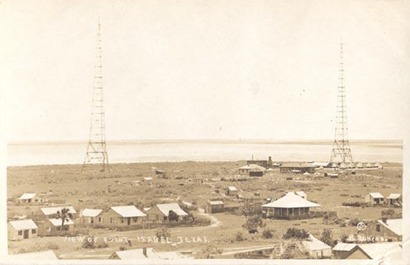| |
Port Isabel Wireless
by Mike Cox | |
When
Gen. Zachary Taylor’s Army arrived at the southern tip of Texas
in 1846 shortly before the outbreak of the Mexican War, it took Old Rough and
Ready two weeks or more to get his orders from Washington.
In 1915, only
69 years later, the U.S. military had plans to install at Point
Isabel a state-of-the-art radio facility that would provide virtually instantaneous
communication as the government prepared for the possibility of a second war with
Mexico. While territorial
expansion may have been a major factor in the 1846-48 conflict, incursions into
Texas by armed insurgents during the bloody Mexican
Revolution would be the triggering event if war came again.
Readers of
the Brownsville Herald learned on April 26, 1915 that the Navy had issued
a call for sealed bids from contractors willing to build two 300-foot radio towers
at Point Isabel (the
community later dropped “Point” and renamed itself Port Isabel).
The
Navy had first installed wireless equipment in some of its vessels in 1903. Within
a decade, most of the U.S. fleet had been equipped for “aerial communication”
as radio was then sometimes referred to. The Navy also had 48 radio stations scattered
across the globe. In the fall of 1912, government engineers selected Point
Isabel as the site for yet another.
When completed, the wireless installation
at the remote fishing village would allow the Navy to communicate with its ships
in the Gulf of Mexico, and via relay to other Naval radio stations and warships
around the world. The station also would provide coast-to-coast communication
as well as direct contact with the government’s primary radio station at Arlington,
Va. In addition, the Texas station would be the prime relay to the newly opened
and vital Panama Canal.
Once in operation, the facility would transmit
the dots and dashes of Morse code (though the Navy encrypted its messages) to
receivers which picked up the signals on giant antennas like the one the Navy
Department planned for Point
Isabel.
Until the Naval facility could go on the air, the government
installed a less-powerful wireless station at Fort Brown in 1914.
Including
the cost of 22 acres, a tract which was purchased from Valley political boss James
B. Wells (for whom Jim Wells County would eventually be named) and Point
Isabel pioneer Charles Champion, who ran the town’s only store, the installation
would cost about $100,000. An estimated 15 Naval personnel would be stationed
there, the newspaper said.
With a war with Mexico looking more and more
likely, work on the giant antennas and other infrastructure continued 10 hours
a day and would have gone on around the clock if electric power had been available
to provide lighting. When the station finally went on the air, sandbags and machine
gun nests protected it from possible attack. Soon, a contingent of National Guard
troops from New York arrived to augment security. |
 |
| Point
Isabel Wireless. Photo courtesy Steve Hathcock , Beachcomber's Museum, South Padre
Island, Texas. |
Despite the Brownsville
newspaper’s optimism that a Naval presence in Point
Isabel would lead to its transformation, five years after the radio station’s
construction, the village slumbered on. The Navy never expanded its presence at
the point, no war with Mexico transpired and after the first world war, Naval
activity in the Gulf declined considerably. Even so, the station still played
a strategic role in its link to the Panama Canal.
“There is not a bathtub
in the entire village,” one newspaper said in 1920. “There is one lone telephone
line which connects it with the outer world, and telegraph facilities are nil.”
In November that year, president-elect Warren G. Harding came to
town for some tarpon fishing. Whether the soon-to-be commander-in-chief had any
interest in Point Isabel’s
naval facility was not reported, by a wire service dispatch did note that a detachment
of Marines “is stationed here and is policing the town.”
Harding’s visit
generated considerable news media attention, and Valley residents again believed
Point Isabel would boom.
While prosperity continued to elude the village, the Naval radio station
played a vital role in military communication and civilian maritime interests.
Twice daily, it and other U.S. Naval facilities broadcast the correct time. The
station also broadcast weather information, including storm warnings.
When
the Navy dispatched the destroyer Robert Smith to stand off Mazatlan, Mexico
during a clash between insurgents and federal forces in March 1929, a wire service
dispatch from San Diego reported that “Owing to radio reception conditions, the
U.S. destroyer Robert Smith and any other American war craft ordered to Mazatlan
will keep in touch with the state and navy departments in Washington by wireless
via the government station at Point
Isabel, Texas.”
Actually, the station had been moved from its original
location to Fort Brown in 1924. Technology advancing almost as fast as the electronic
dots and dashes that had once pulsed from Point
Isabel, only a decade after the facility went on the air, Washington announced
that the radio station was for sale “as it is no longer needed.”
The government
found a buyer for the radio towers, the facility’s buildings and the land that
locals had come to call the Reservation.
For a time during World
War II, when Nazi submarines lurked within sight of the Port
Isabel lighthouse, the military again operated a top-secret radio station
at the still-sleepy town, but it went off the air even before the end of the war.
Three
former Naval barracks, long since converted to private housing, still stand at
the site. A brick structure believed to have been the station’s water plant also
remains, but except for an exhibit in Port
Isabel’s museum, the once important communication facility has pretty much
been forgotten.
© Mike Cox
"Texas
Tales" September
1 , 2009 column |
|
Books by Mike Cox - Order Now |
| |